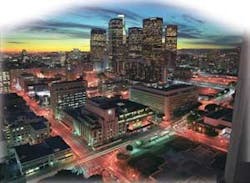By Jerry Labay
The Los Angeles Department of Water and Power (LADWP) is the nation’s largest municipal utility, providing water and electricity to more than 4 million residents and businesses in greater Los Angeles. The water division serves 716,000 water customers, and along with the electric power division, generates sufficient revenue to finance its own operations.
But by the 1980s, the system’s age and size were taking a toll on water service staff, and those in the other municipal agencies – including fire, police, and gas service – who had to deal with huge, outdated paper maps to pinpoint locations of critical infrastructure.
Challenge
“We’ve faced the challenge of manually maintaining our infrastructure data since the mid 1980s,” said Kien Hoang, manager of LADWP’s Water GIS group. “Everything was entered by hand.”
This meant a growing strain on budgets for staff and training as the city grew. Employees spent most of their days updating designs manually and distributing maps on demand. In addition, because the maps were paper, “other groups would make copies of them; copies that would quickly become outdated as we updated our maps. Groups across our organization were using maps that weren’t accurate,” Hoang said.
This led to inefficiencies across the organization. For example, the fire department was operating from outdated maps and wouldn’t have accurate locations of fire hydrants or the gas department wouldn’t know the precise locations of underground water lines.
The department held 100 years of extremely detailed paper maps. These depicted more than 38 million feet of pipe, 716,000 water service connections, more than 200,000 gate valves, and a half-million pieces of additional data, including previous leak locations and legal descriptions. LADWP needed a way to save this valuable data, but maintain it digitally to reduce potential data loss, while maintaining a comprehensive view of all assets.
For a complete view of the water system, LADWP needed maps that integrated the city’s entire land base data, including streets, center lines, easements, and more. The solution needed to manage a massive GIS database and be compatible with other city systems for real-time sharing.
Hoang and his team needed a system that could be adapted to and interoperable with the Oracle Spatial enterprise GIS storage platform used across water and power groups. The answer was a suite of software solutions to bring LA’s water infrastructure into the digital age. Using integrated design and geospatial software, LADWP is able to:
- Complete work faster, with fewer employees
- Reduce data errors
- Decrease time and money spent on staff training
- Share up-to-date GIS data with employees
- Accept and deliver city data in its native format
Pilot Project
After the Northridge earthquake in 1994, Hoang’s group began evaluating potential GIS solutions, taking into consideration their engineering mapping needs as well as the needs of other key user departments. LADWP selected a four square mile pilot area that represented a sample for the entire city in terms of the complexity of the terrain and water system infrastructure. The pilot was successful, but used a retired AutoCAD-based tool. However, the results encouraged Hoang’s team.
“We realized that building our GIS data in the AutoCAD environment would be the key to our success with precision and engineering grade mapping,” Hoang said.
“We decided on Autodesk, in part because we knew it required less time and financial resources to train people because our engineers and GIS professionals were already familiar with the AutoCAD environment,” he said.
The team turned to AutoCAD Map 3D, a geospatially aware version of AutoCAD, which helped the team to work with GIS data from other departments and applications. They also customized their protocol and workflow, developing their GIS system into a powerful object oriented database. Now they control all data in one location, reducing multiple systems or datasets, therefore increasing accuracy and efficiency.
LADWP uses Autodesk MapGuide to publish GIS data over the web for departments needing specific location-based information. For example, field crews now log onto the LADWP intranet to find the exact location of a water hydrant or manhole; this gives them the most accurate, up-to-date information possible on location and equipment status, which leads to better accuracy in the field.
Of course LADWP had thousands of legacy maps that required conversion. The team uses AutoCAD Raster Design to manage those detailed paper maps.
“While we are working to create digital versions of our older paper maps, we use Raster Design to edit and maintain scanned maps digitally,” said Greg Ammon, Water GIS Systems Manager. “The software helps us maintain our existing maps and lets us easily find and use our raster assets.”
The final integrated system offers GIS data creation and maintenance tools, enterprise GIS data storage, and online publishing for other municipal clients of LADWP’s GIS group.
“We accept and deliver municipal data in its native ESRI format with no need for conversion,” Hoang said. “Previously, data conversion often resulted in errors or lost information. The new technology eliminated that risk.”
Result
The new GIS system increases the team’s productivity and efficiency across the water department, saving time and money in maintenance and training. According to Hoang, the solution LADWP has built offers two big advantages.
“First, we chose this path because our personnel were already familiar with AutoCAD, so this reduces the training time and learning curve. Also, because our maps are complex, these tools help us to complete work much more accurately and still maintain good layer separation on these custom maps,” Hoang said.
“The new system helps us to significantly reduce time spent maintaining maps. Not only have we become more productive, but we also have more time to support the water system with increasing services. Because we automated many tasks, we complete projects faster and with more accuracy,” Ammon said. “Quite simply, we are able to do more work in the same amount of time. Now, we can focus on the next task, which enables us to look ahead and plan for the system’s future.” WW
About the author:
Jerry Labay is the Utility Industry Manager at Autodesk, a global design software leader. In this role he defines strategy for utility products that help to improve design processes with model-based design software and increase operational efficiency by leveraging design information across the utility asset lifecycle.



